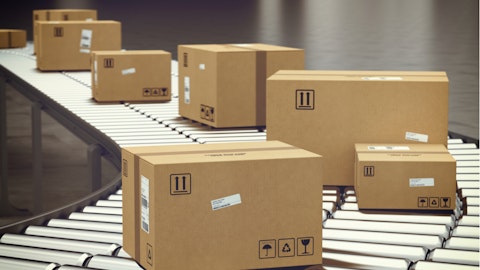So, we are very pleased with the evolution of those two investments. In the case of Brazil, Peru, and Scotland, we are to serve high margin growing businesses with all those investments. What we want to do with them is time them properly with the evolution of demand. At this point, demand is down, so it doesn’t make any sense to accelerate this. So we are just timing the investments with demand. And we will move forward with the advantages that those markets offer. In the Scotland, for example, this in the Scotland investment, we are supporting this high value spirits business, which is a growing category. So we will move forward with that as soon as demand recovers.
John Haudrich: One thing I would add on the later part there is when we take a look at the CapEx, we are not just walking off the job sites of those particular facilities. We are actually, and you’ll see it in our CapEx in the fourth quarter, It is still elevated. We are positioning those projects so that when we get signs that the volumes are returning, we can quickly get back there and finish them up and bring them online, rather than having to kind of start off from scratch, so to speak. So I think that is an important element as we think about it going forward. And embedded in our 550 to 575 next year, is the fact that towards probably the later part of the year or something like that, we are putting in some more CapEx into those facilities and wrapping them up. So some of that finalization costs will be in the back half of next year, a little bit might drag into 2025, but we want to make sure that we are able to respond pretty quickly.
Andres Lopez: Yes, there are a couple of additional data points regards to demand -. Yes, I just wanted to compliment that whole demand landscape. So we are seeing a significant level of activity on new product development in the Americas and so that is something that should support recovery. And one of that is taking in the Andean countries in the markets in which there is significant opportunity for premium products development. And when we look at Brazil, the consumer consumption is quite healthy, and glass overall is doing quite well in that market. And It has been growing in line with premium beer growth for the one-way containers, which is in the mid-teens, and return our containers are emphasized. So the challenge over there is not consumer at all, It is just destocking, which is driven by a significant amount of imports that happen when the supply chains were disrupted, and now It is being consumed so the local orders are lower, but that is a temporary issue, but the consumer itself is in a very good place.
So we will move forward with the investment over there as soon as we clear all these demand fluctuations.
Operator: Thank you. Our next question goes to Anthony Pettinari of Citi.
Unidentified Analyst: This is [Brian Bergmeyer] (Ph) on for Anthony. Thanks for taking the question. I appreciate all the color you have provided on 2024. Just wondering if you can add any detail on sort of your low to mid-single digit volume growth assumption. I think slide eight points to maybe a 2Q inflection in both retail consumption and O-I’s production. What are your customers telling you that sort of makes you feel confident in that target date?
Andres Lopez: Let me provide some input first in with regards to the supply chain. So we identified two different supply chains in our system. The one for — the short supply chain that we call, which is related to we or food or NABs. And we are expecting that supply chain will start to normalize as we exit this fourth quarter of 2023. And there is also a long supply chain, which is spirits and wine. And for that one, we expect that normalization will start in as we exit the first quarter of 2024. So that is incorporated in our projections at this point, and we are seeing some evidence of that behavior. So the short supply chains are already starting to show some initial signs of normalization.
John Haudrich: Yes, I would say, as you can expect right now, we are having a lot of conversations with the customers to understand what their intentions are and building off of Andre’s comments some are pointing that, we are coming to the, the end right now towards here, the fourth quarter, some point to the first quarter, some point to the second quarter. So our outlook is based upon looking at macro information, looking at industry data that points to trends and whatnot. And it also relies very heavily on what our customers are telling us in that regard. So, It is really looking at all three of those variables to come to this conclusion. Of course, nobody has a crystal ball, but it seems to triangulate quite well with all the different inputs that we are hearing from those different sources.
Unidentified Analyst: And last question for me with CapEx maybe coming down a little bit next year what do you view as it is like the best use of cash here is this time to maybe buy back some shares? Do you want to maybe see net leverage closer to two 2.5 times? Do you have any bolt-ons maybe in the pipeline? Just any thoughts you can provide would be helpful.
John Haudrich: Sure. I think our intention is, as we have communicated in a consistently in the past, is that, we are looking right now to reduce debt to that line of sight, a 2.5 times leverage. We are getting close, we had indicated before that the inflection for looking at other more returning value to shareholders through either a dividend or share buyback could be something that we approach here and sometime in the next year, that very well could be valid. Of course, I think, with the macros being what they are, it might take a another quarter or two for things to stabilize itself out, in which case then once you have got good line of sight to that 2.5, again, we are not that far away from it. I think we are entering in this territory of looking at those other options. Ultimately, though, of course, this is a decision for the board of directors.
Operator: Our next question is to Arun Viswanathan of RBC Capital Markets.
Arun Viswanathan: I already asked about the volume trajectory, so maybe you could walk us through how you are thinking about 2024? I understand you maybe put out some guideposts there, but are we really looking for maybe a couple points of growth off of new capacity, maybe some resumption of growth in premium categories? And maybe the end of destocking and some of the lower velocity areas like wine and spirits. Maybe you can just walk us through how you are thinking about how volume evolves over the next say, 12 to 18-months.
John Haudrich: Yes, I mean, It is obviously a complex set of activities right now. We do believe that building off of what Andre said indicated before, some of those faster value chains the beers, the NABs, the food categories probably start to show growth sooner rather than later. Obviously, every segment has its own and every market has its own set of dynamics whereas spirits and wine, for example, might take longer. They entered into their destocking process later than we had seen with some of the other ones. And that is consistent also with what we are hearing from our customers. I think, the view is Latin America obviously hasn’t really seen significant downside. And so as Andre’s indicated before, we are already seeing robust growth coming in with the expansion in the Colombian marketplace, the America, you know, the northern part, you know, North America, et cetera, is actually doing fairly well.




